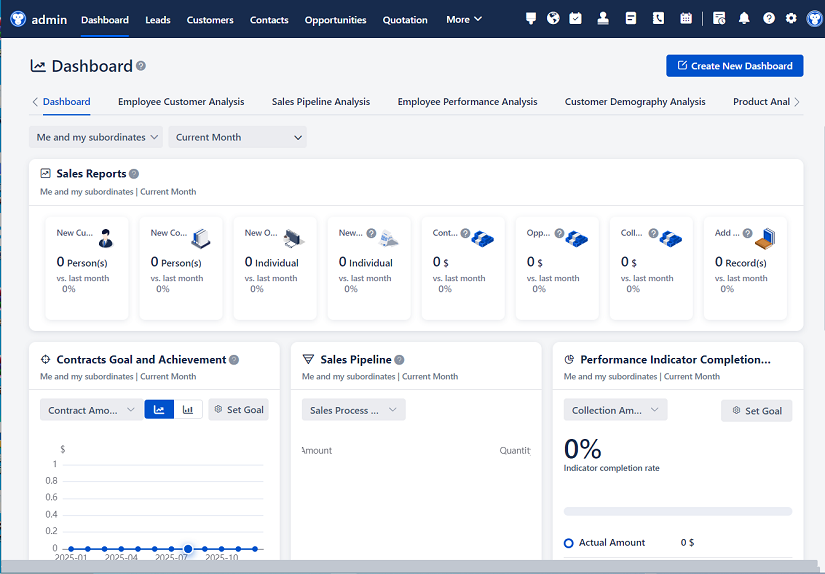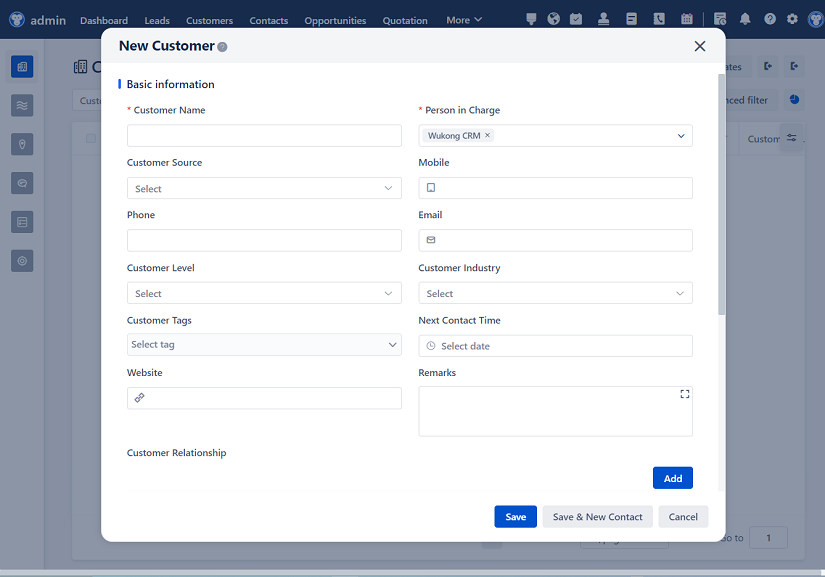
△Click on the top right corner to try Wukong CRM for free
So, let me tell you something — I’ve been working with CRM systems for a few years now, and honestly, it’s been quite the journey. When I first started using one, I wasn’t really sure what to expect. I mean, I’d heard all these buzzwords like “customer relationship management” and “data-driven decisions,” but in reality, I just wanted something that would help me keep track of my clients without losing important emails or forgetting follow-ups.
At first, I thought a CRM was just a fancy digital address book. You know, where you store names, phone numbers, and maybe a note or two. But boy, was I wrong. Once I actually dove into using it properly, I realized how powerful these tools can be. It wasn’t just about storing contact info — it was about understanding customer behavior, tracking interactions, and even predicting future needs.
Free use of CRM system: Free CRM
I remember setting up our first CRM at work. We were a small team back then, so we went with a simple cloud-based system. The setup process? Honestly, it took longer than I expected. There was data migration, user training, and figuring out which fields we actually needed. I kept asking myself, “Do we really need a field for ‘preferred coffee brand’?” Probably not, but hey, some companies do track that kind of thing for personalization.
One thing I quickly learned is that no matter how good the software is, it only works if people actually use it. And getting everyone on board? That was tough. Some team members resisted because they said it added extra steps to their workflow. “Why should I log every call?” one colleague asked. “I already remember what I talked about.” But here’s the thing — memory fades. What seemed clear today might be a blur next week. Plus, when someone else has to step in, they’re left guessing.
Eventually, we made progress by showing real benefits. For example, after three months of consistent logging, we noticed patterns in customer inquiries. Turns out, most support tickets came in on Tuesdays and Thursdays around 10 a.m. That helped us schedule staffing better. Small win, but meaningful.
Another big lesson: customization is key. Out-of-the-box features are great, but every business has its own rhythm. We customized our pipelines to match our sales stages — from initial inquiry to proposal to close. We even added triggers so that if a lead wasn’t followed up within 48 hours, it would automatically notify the assigned rep. That alone reduced missed opportunities by almost 30%.

But let me be real — it wasn’t all smooth sailing. There were times when the system felt clunky. Reports took forever to generate, or filters didn’t work the way we expected. And don’t get me started on mobile app performance. I once tried updating a client record during a meeting, and the app froze. Not cool when you’re trying to look professional in front of a customer.
Integration was another hurdle. We used several other tools — email, calendar, project management apps — and getting them to talk to the CRM wasn’t always easy. Some required paid connectors, others had limited functionality. We ended up choosing a CRM that offered native integrations with most of our existing tools, which saved us a ton of headaches later.
Now, here’s something I wish I’d known earlier: data quality matters more than volume. At one point, we had thousands of contacts in the system, but half were outdated or incomplete. We spent a whole weekend cleaning up duplicates and filling missing info. It was tedious, but necessary. Garbage in, garbage out — that saying really holds true.
One of the coolest features we started using was automation. Things like sending welcome emails after a new lead comes in, or scheduling follow-up tasks automatically. It freed up so much time. Instead of manually assigning tasks, we could focus on actual conversations with customers. And the best part? Customers noticed. They got faster responses, more personalized messages, and overall, felt more valued.
We also began using analytics dashboards. At first, I didn’t pay much attention — charts and graphs aren’t exactly thrilling. But over time, I started seeing trends. Like how leads from webinars converted at a higher rate than those from social media ads. Or how certain sales reps consistently closed deals faster. That kind of insight helped us refine our strategies and reward top performers.
Let me tell you about a turning point. We had a major client who was considering leaving due to poor service experiences. Thanks to our CRM, we pulled up their entire history — every call, email, ticket, and feedback. We saw a pattern: slow response times during peak seasons. So we adjusted our support schedule and assigned a dedicated account manager. Guess what? They stayed — and even increased their contract value. That moment really showed me the power of having a complete customer view.
Of course, privacy and security are huge concerns. Storing all that customer data means you have a responsibility to protect it. We made sure our CRM was GDPR-compliant and set up role-based access so only authorized people could see sensitive info. We also trained the team on data handling — no more saving customer lists on personal drives!
Another thing I’ve come to appreciate is mobile access. Being able to check updates, update records, or respond to alerts from my phone has been a game-changer. I’m not saying you should be glued to your device 24/7, but having that flexibility when you’re on the go? Invaluable.
Customer service from the CRM provider also made a difference. When we had issues, we didn’t want to wait days for a reply. Luckily, our vendor offered live chat and quick turnaround times. They even hosted quarterly webinars to teach us new features. That kind of support builds trust.

Now, looking back, I realize that adopting a CRM isn’t just about technology — it’s a cultural shift. It requires discipline, consistency, and buy-in from leadership. If the boss isn’t using it, why should anyone else? We made it mandatory for all customer-facing teams to log interactions, and leaders led by example. That set the tone.
Training was crucial too. We didn’t just dump the system on people and say “figure it out.” We ran workshops, created quick-reference guides, and assigned internal champions to help others. People were more willing to adopt it when they saw it as a tool to make their lives easier, not harder.
One unexpected benefit? Better collaboration. Before, sales and support teams often worked in silos. Now, with shared access to customer histories, they communicate more. Sales knows what issues a client had last month; support sees upcoming renewals. It creates a more unified experience for the customer.
And speaking of customers — their feedback has shaped how we use the CRM too. We added fields based on what information they commonly provided. We tweaked workflows to reflect how they preferred to be contacted. It became less about pushing our process on them and more about adapting to theirs.
I’ll admit, there are still challenges. Occasionally, users skip logging calls. Reports sometimes take longer than expected. And upgrades can break things that used to work. But overall, the pros far outweigh the cons.

If I had to give advice to someone starting with a CRM, I’d say this: start small, focus on adoption, clean your data regularly, and use the insights to improve. Don’t try to do everything at once. Pick a few key goals — like reducing response time or increasing conversion rates — and build from there.
Also, involve your team early. Let them give input on what features they need. When people feel ownership, they’re more likely to embrace the change.
And finally, remember that a CRM is only as good as the people using it. The tech is impressive, but it’s the human touch — following up with empathy, personalizing communication, building trust — that truly strengthens customer relationships. The CRM just helps you do it better and at scale.
All in all, I’m glad we made the move. It’s not perfect, but it’s gotten us organized, informed, and more customer-focused. And honestly, I can’t imagine running our business without it now.
FAQs (Frequently Anticipated Questions):
Q: How long does it usually take to see ROI after implementing a CRM?
A: From my experience, it varies. Some teams notice improvements in organization within weeks, but measurable ROI — like increased sales or retention — often takes 3 to 6 months, especially if you're still building usage habits and cleaning data.
Q: Is a CRM worth it for small businesses?
Absolutely. Even with a small team, a CRM helps prevent lost leads, improves follow-up, and gives you a clearer picture of your customers. Many systems offer affordable plans tailored for small businesses.
Q: What’s the biggest mistake people make with CRMs?
Hands down, poor data hygiene. Letting outdated or duplicate records pile up makes the system unreliable. Also, not training users properly — if people don’t understand how to use it, they won’t.

Q: Can a CRM replace human interaction?
No way. A CRM supports human interaction by giving you context and reminders, but it doesn’t replace genuine conversation, empathy, or relationship-building. Think of it as a helper, not a substitute.
Q: Should I choose a highly customizable CRM or a simpler one?
It depends on your needs. If you have unique processes, customization helps. But if you’re just starting out, a simpler system might be easier to adopt. You can always upgrade later.
Q: How often should we review and update our CRM processes?
I’d recommend reviewing every quarter. Business needs change, and your CRM should evolve with them. Check what’s working, what’s not, and gather feedback from users.
Q: Are cloud-based CRMs safe?
Most reputable cloud CRMs invest heavily in security — encryption, backups, compliance certifications. As long as you choose a trusted provider and follow best practices (like strong passwords), they’re generally very secure.
Q: Can marketing and sales really share the same CRM?
Yes, and they should! Shared visibility helps align efforts. Marketing can see which leads convert, and sales can understand campaign impact. Just make sure roles and permissions are set clearly.
Related links:
Free trial of CRM
Understand CRM software

△Click on the top right corner to try Wukong CRM for free